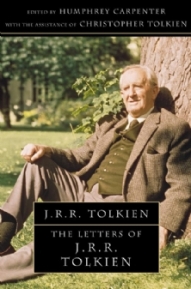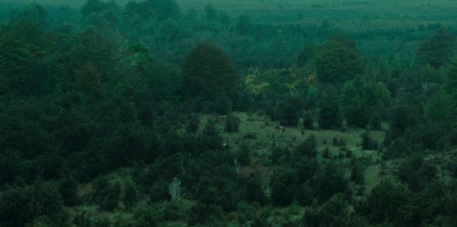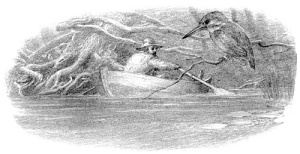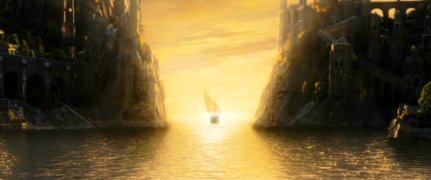Here’s Part IV of the Tom Bombadil article. Please bear with me – it’ll soon be concluded 😉
(Here are Part I, Part II and Part III for those who haven’t been through them yet)
***
1.6 Tolkien’s Letters
Up till now I have tackled Tom Bombadil mainly from the stories he is described in. But what did the author have to say about him?
During his life, Tolkien wrote a substantial amount of letters to relatives, publishers and admirers alike. Many of these contained thoughts about his mythology, tackling clarifications and requests that people often sent him – pertaining to his stories.
From The Letters of J.R.R. Tolkien, we are able to discover those letters that somehow relate to the character of Tom Bombadil.
First of all, for Tolkien, Bombadil represented the vanishing country-side of Oxford and Berkshire.
Let us start by analyzing one of the letters, more specifically Letter 144, written in 1954. Among other things, it states:
“Tom Bombadil is not an important person – to the narrative. I suppose he has some importance as a ‘comment’ … he is just an invention … and he represents something that I feel important … I would not, however, have left him in, if he did not have some kind of function. … Ultimately, only the victory of the West will allow Bombadil to continue, or even to survive. Nothing would be left for him in the world of Sauron.”
So from this paragraph, it seems clear that Tom’s survival, or at least his will to keep on living, depended completely on the victory of good over evil. Having Sauron dominating Middle-earth, the natural world would be destroyed in its wake – leaving Tom with nothing to care for. And even though Tolkien states that he is “not an important person”, he still goes on to say that his inclusion in The Lord of the Rings wasn’t entirely without a reason.
Proceeding to another letter, we come across the matter of the “Master” and what its signification entails. Here follows the piece in question from Letter 153 written in 1954:
“Lots of other characters are called Master; and if ‘in time’ Tom was primeval he was Eldest in Time… he has no fear, and no desire of possession or domination at all. He merely knows and understands about such things as concern him in his natural little realm. He hardly even judges, and as far as can be seen makes no effort to reform or remove the Willow… I do not mean him to be an allegory … but ‘allegory’ is the only mode of exhibiting certain functions: he is then an ‘allegory’ … a particular embodying of pure (real) natural science: the spirit that desires knowledge of other things, their history and nature…”
 So, in Tolkien’s words, Tom Bombadil can be considered as being a spirit, or guardian. He is someone who has no control over others and is not concerned with amending things which seem to be ‘wrong’. It seems as if he takes no sides whatsoever and that his principal interest lies within “his natural little realm” i.e. the Old Forest.
So, in Tolkien’s words, Tom Bombadil can be considered as being a spirit, or guardian. He is someone who has no control over others and is not concerned with amending things which seem to be ‘wrong’. It seems as if he takes no sides whatsoever and that his principal interest lies within “his natural little realm” i.e. the Old Forest.
There is also a footnote to this letter:
“Only the first person (of worlds or anything) can be unique. If you say he is there must be more than one, and created (sub) existence is implied.”
Is Tolkien implying that there are more creatures like Tom Bombadil in Middle-Earth? One might think this is the case …
 As to whether Tom was in fact Ilúvatar himself (the Creator of Arda), Tolkien states in another letter (no.181):
As to whether Tom was in fact Ilúvatar himself (the Creator of Arda), Tolkien states in another letter (no.181):
1.7 Thoughts and conclusions
From all these discussions, quotations and poems, I have just begun to make up my own interpretation of what Tom Bombadil is.
What I have tried to achieve in this article was mainly to gather all possible information on this character and add up everything together in one single piece of work (or rather, four parts).
It seems clear therefore that Tolkien certainly didn’t want his readers to fully understand who and what Tom Bombadil really was andhe believed that this kind of enigma was essential to his stories.
Thus, there can be no clear conclusions on the character; just suggestions and interpretations of one’s own thinking.
To me, Tom Bombadil is a spirit whose main purpose in Middle-Earth is to represent the purity and harmony of Nature.
He lies within his own boundaries in the Old Forest and will remain there until an indefinite time. With regards to his origins, I believe that he was one of those who came into Arda before it was fashioned by the Valar and thus witnessed the major events that we find in The Silmarillion.
He definitely is not Ilúvatar himself and neither a Vala; and with regards to being a Maia, I tend to believe this to a certain extent. It seems clear to me that Tom Bombadil had no desire for any changes whether for good or bad – even though he is represented as benign individual.
After all, the Ainur consisted of more than just Valar and Maiar. In The Silmarillion, specifically the ‘Valaquenta’, we are told:
“ whether of the Valar and the Maiar, or of any other order that Ilúvatar has sent into Eä.”
It is therefore possible that other spirits and beings came into the world apart from the Valar and Maiar; and it would seem that Tom Bombadil was indeed one of these.
To put it in a simpler way – I see him as Mother Nature (or in this case, Father Nature!). A creature whose influence (even though he restricting himself within physical boundaries) is reflected upon all the natural world – unless of course, there are others like him who tend to carry out the same task.
Also, what links Tom Bombadil to Valinor and the Valar, is the one instance in which Frodo dreams of the Undying Lands.
Whilst in Bombadil’s house, in his dream he sees “a far green country opened before him under a swift sunrise”.
We get this vision also at the end of The Return of the King, when Frodo is actually going to the Undying Lands and is reminded of the same dream he had in the house of Tom Bombadil.
This act seems to complete a circle in the narrative, where both ends are linked together and points strongly towards Bombadil being one of the Ainur that form part of Tolkien’s mythology
In conclusion, I tend to think Tom Bombadil as a representative figure of nature – someone who doesn’t really care about the events of the world, as long as the natural things are safe.
He is an embodiment of Middle-earth: constituting all it’s beauty, weakness, power, majesty and strength. Elements which are untouchable by evil and beyond anything physical – relating directly from the essence of Eru Ilúvatar.
***
[Part V concludes this in-depth analysis by focusing on the character of Goldberry]
Copyright of all photos, illustrations and artwork shown here, belong to their respective artists/owners.
Reblogged this on jackconner and commented:
A very nice exploration of Tom Bombadil.
Excellent job my friend, until know I have always speculated that Tom was perhaps a manifestation of Eru, but I am happy that it is not put to rest. keep up the great work.
Thanks Steven. The Eru theory is definitely intriguing but unfortunately pretty much debunked
Oops, correction, this the correct website:
http://www.whoistombombadil.blogspot.com/
Hey James, thanks for the link. Seems quite an in-depth discussion – will going through it asap 🙂
Reblogged this on Twentyish going crazy.
Great write up on your very well thought out and researched background of this enigmatic and important character, it was very well read and received. I do not want to make this response to long or winded, but I must disagree with you about your direct conclusion as to TB not being Illuvatar.
In your above writings: “There is no embodiment of the One, of God, who indeed remains remote, outside the World, and only directly accessible to the Valar or Rulers.”
Unquestionably, this denies any possibility that Tom was in fact Ilúvatar..
One thing that directly stands out is this: only directly accessible to the Valar or Rulers… only directly.. nothing to say about indirectly. Being “Father Nature” would assume that the being overseeing M Earth is separate from its overall creator and designer, but I believe this to be incorrect. Illuvatar created Maia and Valar to help shape and create the physicality of ME, and also to oversee and manage it, as described conclusively in the Silmarillion, after its creation and modifications preceding the coming of Elves and all manner of life.
My conclusions are thus: Tom is an embodiment of Illuvatar, but only in limited form and function, contained in a physical projection of multitude aspects of Illuvatar himself/herself. His confinement to the Old Forest is due to his limited influence on the free will of all living beings on ME. He cannot directly determine the fate of anyone, but is directly tied into the creation of the world, the natural connection of all living things, the deep wisdom and understanding of all things preceding life and the age of the birth of life on ME, which you have referenced very well in your 5 part writeup. The ring does not influence Tom b/c he is above all power given or created on ME and beyond, therefore no power could ever influence him, nor would he have any concern about the corruption of the ring. His power and abilities seem limitless, and the only character that would not be concerned with using that power for influence or control over others or the world he inhabited would be the Prime Creator of said universe. Tolkien was wise in many ways, superseding religious context to the true nature of what God is. Understanding the nature of God means interaction can take place via aspects of the whole, and the exact related concept that God exists around us all, in nature, and in the human form, and in everything we can experience and sense.
Tom is the embodiment of Illuvatar via his aspects, to interact and be a part of that which he would naturally be a part of; the world he gave life to.
These are just my opinions, and I totally respect and admire your writings and thoughts on Tolkien’s work, they are very insightful and comprehensible; it made for a great read. So thank you for taking the time and effort in delving into such wonderful concepts and ideas! Well done my friend.
Sorry for the late reply Scott! Thanks so much for your insightful comments. You bring up some really interesting ideas that are worth a closer look. It just reconfirms that wonders of Tom Bombadil’s character 🙂
Hi, can I use the drawing of Tom Bombadil for a University Work?
I’d be very grateful if you could provide me the name of the author for the copyright.
Regards
Hi Ana, the painting was done by the Hildebrandt Brothers. The pencil sketch was produced by Alan Lee.
Hope that helps 🙂
This passage in the Ainulindale seems relevant:
“But Manwe was the brother of Melkor in the mind of Ilúvatar, and he was the chief instrument of the second theme that Ilúvatar had raised up against the discord of Melkor; and he called unto himself many spirits both greater and less, and they came down into the fields of Arda and aided Manwe, lest Melkor should hinder the fulfilment of their labour for ever, and Earth should wither ere it flowered.”
I contend that Bombadil is one of those “many spirits both greater and less”.
I’m noting your “any other order that Ilúvatar has sent into Eä” observation here, and also noting the distinction between Eä (i.e all of the creation) and Arda (i.e the Solar System); the passage just states that the spirits came to Arda,so it allows the possibility that they already existed within Eä.
Yep, the quote you provide is perhaps the only explanation we can derive from as to the true nature of Bombadil. The rest is pure speculation! 😀